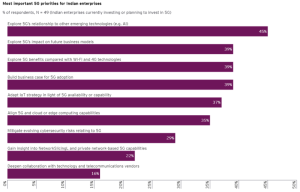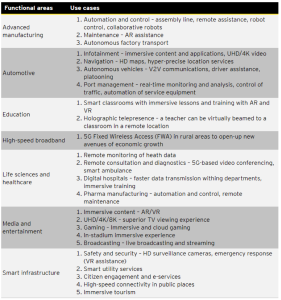5G Perspective
5G priorities, challenges, and impact in transforming lives and unlocking new opportunities in India

It has been over 6 months since 5G was launched in India, and while there has been a lot of buzz around it, users – both individual and institutional – are yet to see its impact. This impact will only be visible in its transformational sense when the full potential of 5G is achieved.
The 5G potential can be unlocked, provided all stakeholders across industries adopt a collaborative approach. For instance, by enabling smart manufacturing, immersive content – AR/VR, immersive/cloud gaming – 5G can transform several industries. 5G is expected to create several new job opportunities in manufacturing, transport, ICT, healthcare, and retail, but upskilling and reskilling the workforce will be critical. Surveys indicate that 70 percent of enterprises are expected to make the highest investment in 5G in the next 3 years, compared to other emerging technologies.
5G priorities and challenges for Indian enterprises
As 5G adoption increases the number of endpoints and use cases, the risks of cyber-attacks and data breaches are paramount for enterprises in India. At the same time, 45 percent of Indian enterprises would like to explore 5G’s relationship with other emerging technologies (e.g., AI). This highlights that 5G priorities underline the need for a holistic approach to emerging technology adoption. However, the real challenge lies in creating financially viable and market-ready use cases. With 39 percent of enterprises seeking to explore 5G’s impact on future business models, the industry’s attention is shifting beyond just technology convergence to adoption of new applications enabled by technology.
Cross-industry collaboration is the key to unlocking the value of 5G
For India to seize the 5G opportunity, all stakeholders must act immediately through a collaborative approach, supported by an enabling ecosystem and the proper regulatory support. Since 5G impacts a wide range of industries, close coordination between various government departments and sector regulators is necessary for the success of 5G in India. A collaborative approach involving all stakeholders – the government, sector regulator, telecom operators, network equipment vendors, technology players and companies across various industries – will help develop India’s 5G ecosystem roadmap.
5G has the potential to change the socioeconomic fabric in India and transform society at large. Providing pan-India connectivity through fixed wireless access (FWA) services could be a game changer, especially in rural areas. 5G FWA is expected to spawn new avenues of economic growth through high-speed internet connectivity in households, improving fixed broadband penetration significantly. 5G has the potential to address some of the primary challenges owing to the lack of optimum infrastructure in sectors, such as healthcare and education. 5G is likely to improve access to education and the quality of virtual learning.

70 percent of the enterprises in India intend to make the highest investment in 5G as compared to other emerging technologies, such as quantum computing, edge computing, analytics and AI, and blockchain in the next three years, (EY survey).

5G – Potential to transform a host of industries in India
The transition to 5G will unlock new use cases and revenue streams through innovative business models. It will bolster the startup ecosystem and enable India to be an R&D hub for 5G technology and use cases. Developing 5G applications is likely to have a significant impact across industries.
India’s engineering/advanced manufacturing segment offers the most significant 5G/IoT opportunity. Multiple use cases exist in this segment with the benefits of increased efficiency, productivity, better safety standards, and highly efficient production. In healthcare, 5G’s benefits can immediately be realized in home-based care and connected hospital devices, as 5G facilitates real-time data transfer. For instance, an intelligent ambulance, equipped with the latest medical instruments, including an HD video camera and portable MRI scanners, can help to transfer real-time data to the hospital. 5G also has the potential to open up remote patient monitoring and diagnosis opportunities in healthcare in rural areas.
The Indian media and entertainment sector is transitioning from passive to participative consumption, fuelled by the popularity of immersive technologies, such as AR and VR, networked gaming, and interactive game shows. 5G may help accelerate this trend and completely transform the consumer experience. Also, there will be an innovation in using 5G to distribute live HD broadcasts in significant events, bringing alive the next-generation stadium experience through in-stadium AR. With the rise in online gaming as its own market segment, 5G can enable massive multiplayer games with immersive worldbuilding.
Further, the advent of 5G may significantly enhance connected-car features, and usher in the age of autonomous vehicles (AV) in India. It will connect vehicles-to-vehicles, roadside infrastructure, road users, and cloud services to improve transportation experience and quality of life. On the other hand, 5G’s ability to support many sensors and real-time dissemination of information and analysis makes it suitable for several smart city functionalities, ranging from intelligent utility services to automated taffic management. 5G significantly enhances safety and security by supporting high-throughput real-time video surveillance.
The industry and users have spent enough time dreaming of the 5G painting. All that remains is to wake up and finish painting the 5G dream.
The article is co-authored by, Siddhey G Shinde, NITI Aayog















You must be logged in to post a comment Login